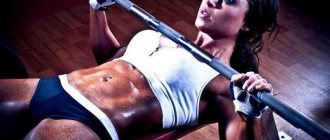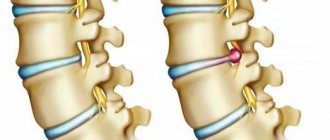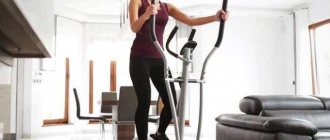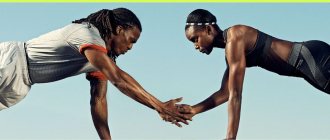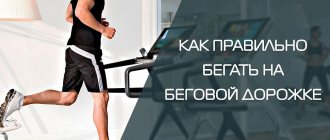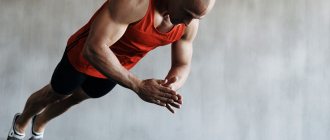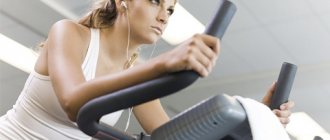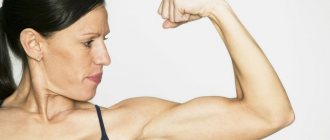- MixSport
- News
31953
17455
30.03.2019
It happens that a woman in training can move mountains. And it happens that even the simplest exercises do not work out. The fact is that the effectiveness of training depends on the menstrual cycle. Therefore, for each phase of the cycle you need to select the right loads.
It happens that a woman in training can move mountains. And it happens that even the simplest exercises do not work out. The fact is that the effectiveness of training depends on the menstrual cycle. Therefore, for each phase of the cycle you need to select the right loads.
We visited FKCUP SPORT, where we listened to a lecture by the famous obstetrician-gynecologist, STB TV channel expert Lyudmila Shupenyuk . We tell you what phases the menstrual cycle consists of, what happens during each of them, how to select loads depending on the cycle and whether it is possible to play sports during menstruation.
Training plan within a cycle
| The menstrual cycle (Latin menstruus - monthly, monthly) is a natural cyclical change in a woman’s body, repeated at certain intervals and externally manifested as menstruation. |
On average, the monthly female cycle is 28 days . This period is divided into 5 phases depending on changes in the level of major hormones that affect the body.
The recommendations given for each phase must be taken into account by all women, regardless of how they feel during the cycle.
Menstrual phase (1 – 5 (7) days)
Physiology of the phase:
- follicle growth and the beginning of active estrogen production;
- the number of red blood cells in the blood decreases (by about 1 million) and the level of hemoglobin decreases (by 15%). Such changes are observed in 50% of women. On the 8-10th day after the first day of menstruation, these indicators return to normal.
- the aerobic capacity of the body decreases;
- during exercise, the heart rate and breathing rate increases;
- Muscle strength, speed and endurance may decrease, but flexibility improves;
- the pain threshold and susceptibility to injury increases.
Recommendations
During this period, you should not plan complex strength training and put an accentuated load on the abdominal muscles. If your health worsens these days, you can focus on gentle practices, stretching, and relaxation.
| Low-intensity and moderate exercise, according to experts, will help you painlessly and easily survive KD and relieve cramps in the abdominal area by increasing blood circulation in the pelvis. |
Replace your usual workouts with low-intensity strength training (fewer sets), gentle yoga, Pilates, swimming, walking and gentle cycling.
| The reason for refusing physical activity these days may be painful periods, general poor health, and a woman’s general reluctance to exercise. |
Positive sides
Scientists have long refuted the fact that physical activity affects reproductive functions. On the contrary, there are positive aspects of this process:
- exercise helps increase libido;
- weight returns to normal;
- physical activity has a beneficial effect on the immune system;
- insulin production increases;
- the functioning of the thyroid gland is normalized;
- the more a woman is exposed to physical activity, the higher the chances of conception;
- metabolism is normalized;
- heart function improves;
- sleep is normalized.
Note! During the exercises, not only the body, but also the internal organs are strengthened, and subsequently all this will help to carry the baby without problems.
Postmenstrual phase (6(8) – 12(13) days)
Physiology of the phase:
- the level of estrogen production increases sharply, stimulating an anabolic effect in muscle tissue;
- the overall level of progesterone and testosterone increases;
- overall performance and endurance increases;
- The cardiovascular system works better.
Recommendations
These are the best days to train your strength and endurance. You yourself, most likely, have noticed how a lot of strength and energy appears after a CD. This is a great time for fitness, working with weights on large muscles throughout the body, as well as for cardio of any type.
| You can do HIIT, CrossFit, cycling, kickboxing and go through all sorts of intensive bootcamp-type programs. |
Ovulatory phase (13–15 days)
PHASE PHYSIOLOGY:
- estrogen levels are just beginning to decline from their highest levels, and progesterone levels are still low;
- there is a decrease in performance, physical work requires more expenditure from the body;
- a woman may feel mild pain in the lower abdomen, increased appetite and libido;
- in women, the part of the brain responsible for emotions and memories increases (research by scientists from the Max Planck Institute);
- a woman is at the peak of her fertility, sexuality and femininity.
RECOMMENDATIONS
High estrogen levels negatively affect collagen metabolism, so the risk of injury during this period is quite high .
Professional trainers
recommend slowing down and doing yoga, dancing, ballet, Pilates, you can do long cardio sessions - this is a regular run at a medium pace in the fresh air or running on an elliptical trainer in the gym.
Last two weeks of the menstrual cycle
Luteal phase - less energy for training. But this does not mean that you need to force yourself. Heavy training at this time has a negative effect on the muscles. Therefore, you need to concentrate on fat burning. Because in the Follicular phase, along with the muscles, you gained a little fat, then in the Luteal phase you need to let the muscles rest and recover, and burn the fat. Cut calories: minus 5-15% of normal, or more if you need to burn more fat and can sacrifice some muscle.
The minimum number of workouts at this time is 1-2 strength training per week. Working weights can be reduced by 5-10%. If you want to burn more fat, add 1-2 low-intensity cardio workouts for 20-40 minutes. This training and nutrition strategy will help achieve two goals:
- preserve muscle and burn fat
- increase muscle responsiveness to heavy training in the follicular phase
The muscle mass you worked hard for the first two weeks (follicular phase) will not go away if you let it rest for the last two weeks and do strength training only 1-2 times a week. Muscles do not grow during the workout itself, but when you rest. And research shows that after a short rest, they become more responsive to subsequent training. All this in the long run gives you more muscle growth than if you train at the same intensity all the time.
What if I like to exercise often?
For some, it is easier to always train with the same frequency, because... training only 1-2 times a week is relaxing and after that it’s hard to get into the rhythm again. If this is your case, then train all the time with the same frequency (3-4 strength training per week), but in the Luteal phase, reduce the volume of training by 30-50% (fewer repetitions and sets, less working weights, shorter workouts).
Postovulatory phase (16 – 24 days)
PHASE PHYSIOLOGY:
- estrogen begins to decrease, and progesterone, on the contrary, begins to actively increase;
- possible mood swings, increase in body temperature by 1 degree;
- decreased performance, feeling of bloating and swelling throughout the body;
- Metabolism becomes less active compared to the follicular phase, and the body is less willing to burn fat.
RECOMMENDATIONS
A balanced, balanced diet will best help reduce discomfort in the body.
For physically prepared girls, during this phase of the cycle, training is recommended that helps the body use fat as fuel. There is less strength at this stage, so short intense exercises, short interval running on a cardio machine, intense aerobics, strength or active types of yoga (Ashtanga-Vinyasa Yoga), tai-bo, swimming are suitable.
For those who are less prepared, moderate exercise, group strength classes in a fitness club, hatha yoga, strength Pilates, swimming and fitball exercises are recommended.
| Training will give a natural surge of endorphins, lift your mood, make you feel better, and increased sweating during this period during physical activity will help remove excess fluid from the body. |
When sports are contraindicated during menstruation
The most common example demonstrating how going to the gym affects the menstrual cycle is athletes who perform during their menstrual periods.
Due to heavy loads, a woman’s body suffers from thyroid disorders. Constant stress causes hormonal imbalance, which can lead to delayed menstruation. Changes in the menstrual cycle begin to develop from the first days of visiting sports sections or the gym. In 80% of cases, with regular heavy exercise, menstruation is delayed by 2-3 days, but sometimes this period can be more than a week.
Before you start actively playing sports, you need to consult with a specialized specialist. He will tell you when to train to avoid problems with your cycle.
Before you start seriously exercising during menstruation, you should see a doctor.
It is worth remembering that every organism is unique. For this reason, he may tolerate physical activity differently. However, it is safe to say that sport is a factor that leads to irreversible pathological disorders.
Most often, with regular active training, the heart and blood vessels suffer. When it comes to a woman's sexual health, serious exercise leads to hormonal imbalance, which ultimately contributes to the development of menstrual problems.
Experts identify types of exercises and physical activity that have a beneficial effect on a woman’s body during menstruation. These include yoga, swimming and Nordic walking.
Doctors identify a number of factors in the presence of which participation in intense sports activities is contraindicated during menstruation. Among them, the most common are:
- presence of acute pain in the lower abdomen;
If there is inflammation, it is better to postpone classes
- increased amount of discharge;
- deterioration of general health;
- acute infectious diseases;
- chronic inflammatory processes in the acute stage.
If there are clinical signs of any disease, you should immediately stop playing sports and seek advice from specialized specialists. This will help avoid the development of possible complications and preserve the woman’s health.
Most experts believe that minimal physical activity at the beginning of menstruation will help overcome the depressive state of a woman’s body. But you should not perform excessively intense exercises, so as not to lead to heavy discharge or pain in the lower abdomen.
If you exercise properly during menstruation, a woman can get relief during this period. Some of the most suitable exercises for this purpose include yoga, jogging and walking. They will not only improve your well-being, but also strengthen various muscle groups. In addition, with their help you can eliminate tension that has accumulated in the back and lower extremities.
Most modern women prefer to lead an active lifestyle, and even during menstruation they do not stop playing sports, fitness, dancing and other active activities. However, not everyone is aware of the changes that occur in the body during this period, during which it is impossible to demand the desired results from the body.
Menstruation is a physiological process in which the body gets rid of biological substances that are unused due to the lack of fertilization of the egg.
At the beginning of the menstrual cycle, the intrauterine membrane separates. This natural progression should not be considered a disease, but all women experience symptoms differently these days. This is mainly pain in the chest and lower abdomen, dizziness accompanied by nausea, bloating, increased or decreased blood pressure, sweating and cramps. All this happens due to changes in hormonal levels.
No matter how your periods go, even if they are not accompanied by certain physical inconveniences, it is recommended to abandon your usual lifestyle for this period. This should be done in order not to harm the body, which is in a special state. The restrictions that must be adhered to are as follows:
- in physical activity and sexual activity;
- in following diets, stopping drinking alcohol and smoking;
- in cosmetic and water procedures;
- in processes requiring surgical intervention.
However, you should not mistake your period for some illness that requires bed rest. Doctors recommend leading a lifestyle with moderate activity during the menstrual cycle. A complete state of rest these days will further aggravate the discomfort, so staying in bed throughout this entire period is very undesirable.
Research conducted by scientists has shown that regular sports activities during menstruation help reduce the severity of premenstrual syndrome. Systematic training reduces breast tenderness and discomfort in the lower abdomen in women, accelerates the supply of oxygen to the cells and eliminates mood changes.
It follows from this that it is possible to exercise during the menstrual cycle, since they allow you to maintain the necessary tone of the body muscles. Metabolism and blood circulation in this case are significantly improved. Nevertheless, the load on the body should be moderate and correspond to the physical condition.
Women who do not have gynecological diseases and are in normal health during menstruation are allowed to exercise according to a standard program, except for exercises associated with weights. Barbells and weight machines cause tension in the muscles of the perineum and abdominal wall, which leads to the release of blood into the abdominal cavity and the risk of endometriosis.
If you have gynecological diseases, such as uterine fibroids or endometriosis, you should refrain from exercise. Under these circumstances, due to sports activities, fatigue will increase, and there is a possibility of progression of the pathology. Exercising during painful periods (dysmenorrhea) will lead to a deterioration in well-being, increased discomfort and an increase in the volume of blood released.
In the absence of the opportunity to exclude physical exercise, before starting it, a woman should consult a gynecologist. Ignoring the recommendations of doctors and competent advice from trainers can lead to various complications. For example, the pelvic floor muscles may lose the ability to fully perform their functions, and the pelvic organs may undergo prolapse, urinary incontinence and heavy bleeding may occur. In addition, incorrectly chosen physical activity during menstruation can create a threat of premature birth.
Many gynecologists suggest reducing the usual loads by thirty percent in the first days of the menstrual cycle. Exercises must be properly designed and standardized, only in this case they will not lead to negative consequences and will improve well-being during PMS. During their difficult period, women can engage in various sports.
The most accessible and widespread of them is running; doctors recommend it as the most ideal sports activity during menstruation. When moving, it is advisable to adhere to a moderate pace and maintain it throughout the entire process, avoiding increasing or decreasing speed. In addition to using a treadmill, it is also advisable to do this outdoors, choosing a route without elevation changes. If a woman feels unsatisfactory these days, running can be replaced by brisk walking.
Thanks to a variety of modern hygiene products used to absorb the blood released, physical activity during menstruation can be performed while in the pool. Swimming at a moderate pace and water aerobics are useful; these exercises allow you to work out the lower part of the body.
Water exercises easily relieve a woman of lower back pain and minimize spasms of the uterine muscles. When visiting the pool, you must carefully follow the rules of hygiene and pay attention to the water temperature; exercising in cold water is completely unacceptable. Gynecologists also prohibit sports activities in natural bodies of water.
During critical days, you can also visit the gym, but preference should be given to exercises that help strengthen the cardiovascular system and increase lung capacity. These include exercise on an exercise bike, treadmill and step aerobics. Martial arts, shaping, Pilates and dancing will not harm a woman’s health. During such exercises, the pulse increases slightly and the general condition of the body improves.
Bodyflex during menstruation is not categorically prohibited by specialists, but at the same time it is necessary to assess your well-being: if it is not unimportant, then it is recommended to abstain from these activities. Bodyflex is able to stabilize the menstrual cycle and get rid of adhesions located in the uterus. The programs performed should not contain exercises associated with stress on the abs and pelvic organs; in addition, retracting the abdomen is also contraindicated.
When practicing yoga during menstruation, emphasis should be placed on hatha yoga asanas and yogalates. With their help, a woman’s pain in the lower abdomen will disappear, the frequency of spasms will significantly decrease, which will have a beneficial effect on her general condition.
When asked whether it is possible to exercise during menstruation, most gynecologists and trainers gave a positive answer. But at the same time, it is necessary to have information about what needs to be excluded from sports activities. There is a list of actions prohibited during menstruation:
- body rotation;
- rocking the press;
- all kinds of power loads, for example, pulling and lifting heavy equipment;
- vigorous aerobics or shaping with sudden movements;
- jumping in place and using a skipping rope;
- loads on the lower back and abdominal area.
Premenstrual phase (25 – 28 days)
PHASE PHYSIOLOGY:
- the concentration of estrogen and progesterone in the blood falls, reducing the functionality of the body;
- probably depressed mood, irritability, apathy;
- slight weight gain is possible (this is normal!).
RECOMMENDATIONS
Trainers allow you to skip a couple of classes at the end of the cycle if your condition is not at all conducive to performing exercises. During physical activity, it is recommended to avoid jumping, abdominal stress and inverted yoga poses. The power load should be moderate.
| Compared to other phases of the cycle, the intensity of exercise during this period should be the least. |
Walking in the fresh air and swimming will help relieve unpleasant symptoms of the premenstrual phase..
Researchers at the University of Sports in Vancouver say women who exercise regularly report less breast tenderness, bloating and mood swings compared to those who don't exercise.
| If your cycle is more or less than 28 days, you should carefully observe yourself for 2-3 months in order to more accurately determine the moments of transition from one phase to another. |
What physical activities are useful when planning pregnancy?
To carry a baby, you will definitely need strong back and abdominal muscles, which is why it is so important to strengthen them at the planning stage. In addition, stretching is important, and special attention should be paid to the muscles located in the perineum. You also need to take into account that the sacrum plays an important role during pregnancy and childbirth, and therefore it is necessary to perform exercises to stretch the transverse twine.
When choosing a sport, you need to consider when exactly you are planning a pregnancy. If the conception of a child should occur in six months, then there should be no restrictions. If pregnancy can occur at any time, you will have to give up those sports that include all kinds of jumps and leaps. Loads that are likely to cause falls and injuries are also contraindicated. When planning a pregnancy, sports excludes exercise in the gym, fitness, and callanetics.
It is best to choose the following sports:
1. Swimming.
This is a great way to prepare the body for conception. Moreover, the onset of pregnancy is not at all a reason to give up this sport. At the same time, it is very important to pay attention to the cleanliness of the water in the pool, because infection with various infections can become an obstacle to successful conception.
2. Pilates.
This sport is very useful when planning pregnancy, as it helps strengthen the muscles of the pelvis and back. In addition, Pilates helps you relax and teaches you to control your breathing. However, it is very important to be careful when performing abdominal exercises and activities that involve tensing your abs. Don't strain yourself too much.
3. Yoga.
This is perhaps the ideal sport when planning a pregnancy. Stretching combined with proper breathing will provide excellent assistance to expectant mothers. Thanks to regular exercises, you can calm the nervous system, organize your thoughts, and prepare your body for conception. Moreover, in yoga there are asanas that are intended for conception and pregnancy. Their implementation will help women who cannot get pregnant.
4. Bodyflex.
This sport is useful only for those women who are sure that conception has not yet occurred. It should be borne in mind that after pregnancy, bodyflex is strictly contraindicated.
INFLUENCE OF CYCLE PHASES ON THE PHYSICAL AND PSYCHOLOGICAL STATE OF A WOMAN
Menstrual function begins during puberty and continues until the age of 45-55. A regular cycle is established immediately after menarche (the period when menstruation first appeared) or over the next 1.5 to 2 years.
Its duration is calculated from the first day of the onset of menstruation to the first day of the next menstruation and is characterized by a fairly wide range of individual physiological fluctuations (from 21 to 35 days, on average - 28).
A normal cycle consists of two main phases of changes in ovarian function : follicular and luteal.
- Follicular phase (0 – 14 days). During this time, the formation of a dominant follicle occurs, and ovulation occurs (the release of the egg from the follicle).
- Luteal phase (14 – 28 days). After the egg is released from the follicle, the corpus luteum forms in the ovary, which secretes estrogen and progesterone to prepare the body for pregnancy.
The physiological state, desire and ability of a woman to devote herself to physical activity are influenced by the level of hormones and external factors.
- Changes in hormone levels in different phases of the cycle. The greatest influence on the female body during the menstrual cycle is exerted by estrogens (estradiol), gestagens (progesterone) and androgens (most of all testosterone).
- External factors. Over the past decades, a sufficient number of observations have accumulated that show that training at a professional level or regular intensive CrossFit classes can lead to disorders of the reproductive system of female athletes.
Exercises
At the pregnancy planning stage, pay attention to the following exercises:
- swimming. Water treatments help completely strengthen the body. The lower back, limbs and spine begin to perform their functions better. In this way, the body prepares for pregnancy.
- Yoga. Exercises within the framework of this technique will not harm you at all. On the contrary, in yoga there are special asanas that contribute to the successful consolidation of sperm. In addition, a good stretch appears, the woman calms down and relaxes.
- Bodyflex. This technique strengthens the abdominal muscles. They can be performed before pregnancy.
- Pilates. This practice involves breathing exercises aimed at strengthening the muscles of the pelvis, abdomen and lumbar region. During ovulation, you should not pump up your abs. In case of the slightest discomfort, the load should be eased.
- Roller skating and ice skating. This pleasant activity strengthens the leg muscles, tightens the stomach and buttocks. It's also great cardio.
- In the middle of the cycle you can attend dance classes, gymnastics and aerobics.
RESEARCH AND OPINIONS
According to Elena Kochetkova and Olga Oparina, biological rhythms are closely related to physical performance. The main research in this area concerns female athletes and the influence of their biological cycle on athletic performance. It is known that the course of MC affects women sprinters the least and most of all – athletes training for endurance.
According to numerous studies in various sports disciplines, the most unfavorable phases of the cycle for serious physical activity are phases 1, 3 and 5 . During these phases, the lowest rates of speed, strength, speed-strength exercises, as well as speed endurance were recorded.
| Directly on the days of menstruation, it is not recommended to perform strength exercises, which are accompanied by straining, sudden movements and cooling of the body. The volume of strength training these days should be small. |
It has been established that with increasing experience in sports performances and increasing sportsmanship, the negative impact of the so-called unfavorable phases on special performance (performance associated with a particular sport) decreases noticeably. Thus, the more trained a woman is, the less negative influence she experiences from phases 1, 3 and 5 , provided there are no problems with MC due to serious physical exertion.
Optimizing your workout depending on the day of your cycleIn 2014, a study was conducted to determine changes in strength abilities and psycho-emotional state of women depending on the phases of MC. 12 women aged 20-25 years were under observation. The study included questionnaires and practical tests. The questionnaire revealed the subjective attitude of the experiment participant to the question, her condition and the body’s reactions to physical activity, and the presence of changes in the course of the cycle. The researchers were interested in whether the athletes associated these changes with the training performed, and what they did in case of cycle failures. All women noted the connection between the specifics of training and the nature of the cycle. The greatest volume of training has always been given during those periods when women’s bodies are predisposed to perform it. For athletes who have a 28-day cycle, physical activity was increased on days 7–12 and 16–25, and decreased on days 1–6 and 13–15 of the cycle. During the entire cycle, exercises of a selective nature by muscle group were used. For example, 1–2 days before and on the days of menstruation, exercises were chosen that did not cause much tension in the muscles of the lower abdominals and pelvis. It was revealed that the dynamics of the manifestation of special endurance and speed capabilities have ups and downs according to the phases of the menstrual cycle. The highest rates were observed in girls at the beginning of the postmenstrual and postovulatory phases of the cycle , which corresponds to peaks in the content of sex hormones and associated fluctuations in the performance of female athletes. The lowest indicators of special endurance and speed capabilities in power sports were found in the menstrual and ovulatory phases. |
In practice, your coach or you yourself must take into account the decrease in performance and psychophysiological functions of the body in different phases of the cycle .
| A large load on the pelvic muscles, abdominal muscles and cardiovascular system during the premenstrual and menstrual phases can adversely affect the health and dynamics of a woman’s cycle. |
It is optimal to complicate the training program as much as possible on postmenstrual and postovulatory days. During periods of decreased performance, it is necessary to avoid heavy physical activity and rest more often.
The first two weeks of the menstrual cycle
In the Follicular Phase, focus on heavy training: compound exercises (squats, deadlifts, etc.) 3-5 times a week, more sets, more different exercises in each workout. The daily calorie intake is + 5-10% of the norm (if you are building muscle mass), if you are losing weight - without a surplus (i.e. at the level of the daily norm).
Is it possible to exercise during menstruation?
Ideally, with the start of a new cycle and the Follicular phase (the first day of your period), you can begin heavy training. But if you have a hard time with your periods (the first 3-5 days), then start hard training on days 3-5 (at the end of your period). And in these first 3-5 days, do not exercise or do cardio (if you have the strength). If you are lucky and have an easy period, start heavy training on the first day of your cycle.
CONCLUSIONS
The menstrual cycle is an automated, streamlined process designed by nature. This is definitely not a disease, but only a feature of the female body, but the feature is important because it is responsible for reproductive function.
Physical activity, which takes into account the woman’s condition at each moment in time, contributes to a painless and calm course of the cycle.
Knowing the patterns and cyclical distribution of hormones, as well as observing yourself throughout the month, you can independently adjust your training schedule. Within one direction, you can increase and decrease the intensity of classes. Within different ones, plan so that more intense training coincides with phases of increasing performance.
In general, everything is quite individual, you need to listen to your body. Exercise for your health and remember to rest when your body requires it.
Literature: 1. Human physiology: textbook / A.A. Semenovich [etc.]; edited by A.A. Semenovich. – 3rd ed., rev. Minsk: Vysh. school, 2009. – 544 p. 2. Human physiology / Ed. G.I. Kositsky. – 3rd ed., revised. and additional – M.: Medicine, 1985. – 544 p. with ill. 3. Normal physiology. Short course: textbook / V.V. Zinchuk, O.A. Balbatun, Yu.M. Emelyanchik; edited by V.V. Zinchuk. – Minsk: Vysh. school, 2010. – 431 p.: ill. 4. Orlov R.S. – Normal physiology: textbook. – 2nd ed., rev. and additional – M.: GEOTAR – Media, 2010. – 832 p. : ill. 5. Physiology of sports and physical activity - Wilmore J.H., Costill D.L. - Textbook. - Kyiv. Olympic literature, 1997. – 503 p. 6. Belyaeva K.G., Glushchenko, Karlyuk Yu.N. On the level of special performance of track and field athletes in various phases of the menstrual cycle / In the book: Women's sports. 1995. 7. Kalinina N. A. Diagnosis and prevention of disorders of the reproductive system of female athletes // Theory and practice of physical culture. 2004. No. 1. 8. Kochetkova E.F., Oparina O.N. — Physiological features of the organization of the educational and training process of girls in strength sports // Research in the field of natural sciences. 2014. No. 8 [Electronic resource]. URL: https://science.snauka.ru/2014/08/8264 9. Dissertation on the topic “Adaptive changes in psychophysiological functions in women under the influence of physical and emotional stress” Candidate of Biological Sciences Bulatova Tamara Evgenievna, Kurgan 2004 10. Electronic scientific journal Modern problems of science and education ISSN 2070-7428 Magazine issue No. 4 for 2020 “MENSTRUAL CYCLE: DISTURBANCES WHEN EQUALIZING THE LENGTH OF THE THIGH AND SHIN, RECOVERY ALGORITHM” 11. Article by R.V. Gorbunov “Comprehensive assessment of the functional state of women in different phases of the menstrual cycle”, Hospital of the Medical Emergency Department of the Moscow ZhK “Krasnodarsky”, Krasnodar Internet resources: 12. Eunsook Sung, Ahreum Han, Timo Hinrichs, Matthias Vorgerd, Carmen Manchado and Petra Platen: “Effects of follicular versus luteal phase-based strength training in young women", SpringerPlus20143:668, DOI: 10.1186/2193-1801-3-668©, Sung et al.; licensee Springer. 2014, Published: November 11, 2014. 13. Len Kravitz, PhD, Afton Cazares, MA and Christine Mermier, PhD: “Women, Hormones, Metabolism & Energy Expenditure,” IDEA Health & Fitness, Jun 28, 2013. 14. Biological Rhythms and the influence of the phases of the menstrual cycle on the performance of female athletes. O.V. Golubkova, obstetrician-gynecologist, master of sports
